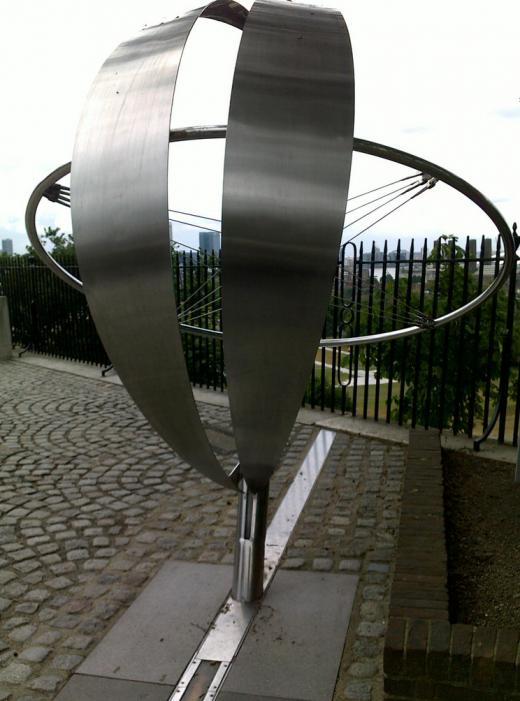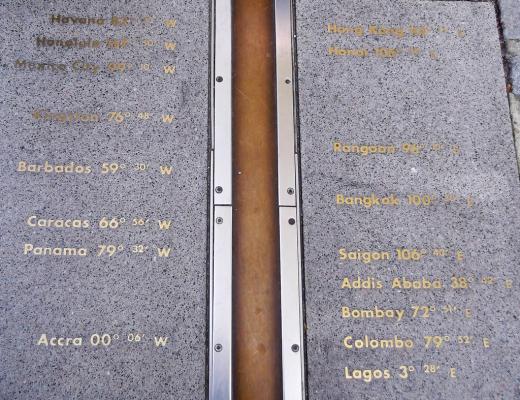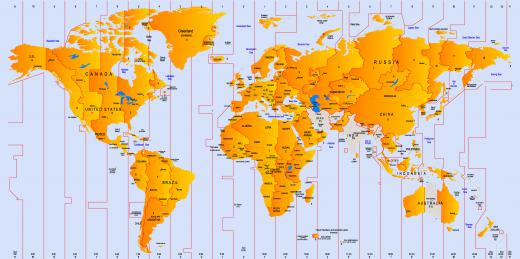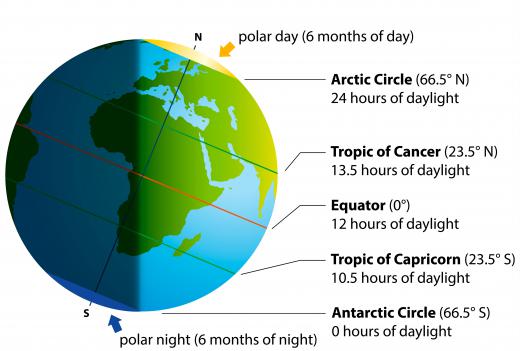What are Latitude and Longitude?
 Mary McMahon
Mary McMahon
Latitude and longitude are both measurements that people can use to find where they are on Earth. With very precise instruments, a person can pinpoint his or her location within inches using latitude and longitude. The discovery and refinement of latitude and longitude were vital to early navigators, and the principles continue to be used on a daily basis both at sea and on land. Discovering your precise latitude and longitude coordinates in the modern era is as easy as purchasing a global positioning satellite receiver, which can communicate with satellites over the Earth to triangulate your position.
Both latitude and longitude have values represented in degrees. The degrees are sometimes called hours, and they are further subdivided into minutes and seconds for an extremely precise set of coordinates. When looking at a set of coordinates, the latitude is written first, followed by the longitude. The coordinates read from left to right, starting with the number of degrees, followed by minutes, and then seconds. Minutes are marked with a single apostrophe ('), and seconds are delineated with a double apostrophe (“). At the very end, a letter will indicate whether the measurement is in the North, South, East, or West.

Lines of latitude were established before longitude was. Each minute of latitude is equal to one nautical mile, measured as 6,076 feet (1,852 meters). Latitude is an angular measurement representing how far away from the Equator someone is standing. At zero degrees of latitude, someone is standing on the Equator. The numbers get larger as the person travels North or South. Lines of latitude can be thought of as circles hugging the globe; the largest circle is at the equator, and the smallest circles are at the poles.

Several lines of latitude are considered important enough to be named. The first is the Equator, at zero degrees. The second are the Tropics of Cancer and Capricorn, located at 23° 26' 21” North and South, respectively. Finally, the Arctic and Antarctic circles, at 66° 33' 39” North and South. These lines of latitude represent important boundaries on the surface of the Earth which determine the seasons and weather in the areas which they pass through.

Longitude measures how far away someone is from the Prime Meridian, which runs through Greenwich, England. By convention, a longitude coordinate indicates whether it is to the East or the West. In some countries, a minus sign in front of a longitude coordinate indicates that it is in the West, while a plus sign indicates the East. Some confusion has arisen over this, however, so most people mark lines of longitude as either East or West with an E or W after the coordinates.

Unlike latitude, the physical distance that a line of longitude measures varies depending on the latitude of the observer. Someone at latitude zero would be approximately sixty nautical miles, or sixty nine statute miles (111 kilometers) away from the prime meridian at one degree of longitude, while someone at the pole would be zero nautical miles away from the prime meridian at any degree of longitude, since the lines meet at the poles.
AS FEATURED ON:
AS FEATURED ON:














Discussion Comments
Who discovered latitude and longitude did he get his award?
Post your comments